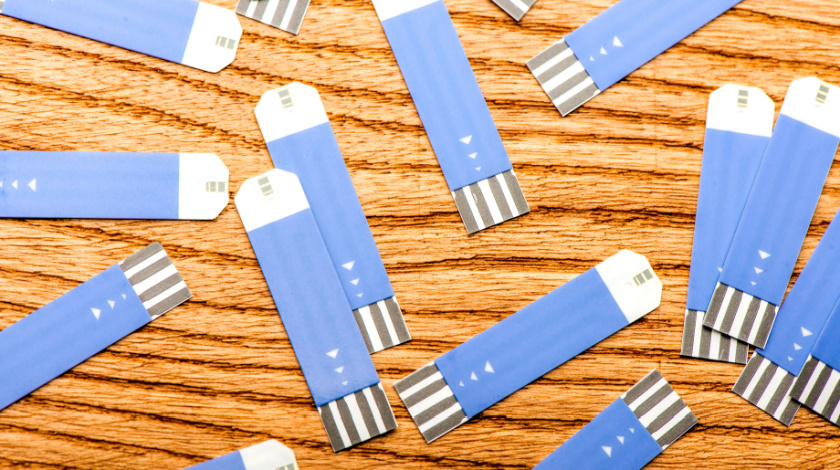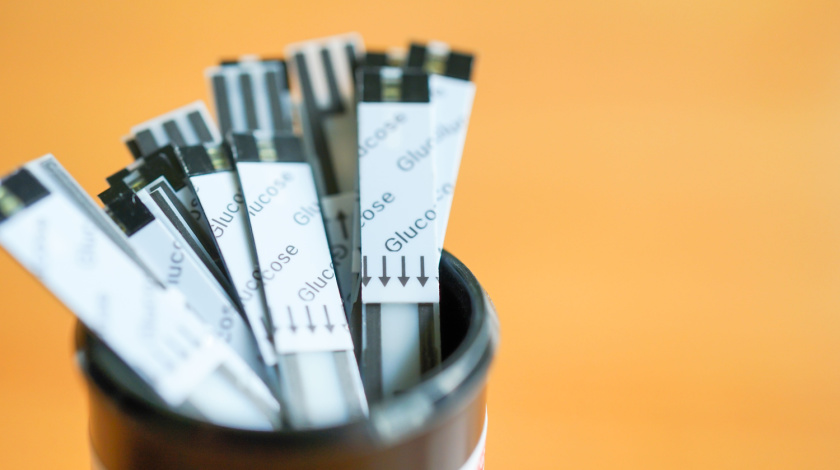With progress comes change, and changes are often accompanied by challenges. Our complex, technology-centric lives have turned us into robots, while our cocooned, sedentary bearing has made us vulnerable to serious illnesses. And one of them is diabetes. Although this ailment can be reversed through lifestyle changes, chronic diabetes also needs glucometer and glucometer strips as a part of diabetes management. In this blog, we will discuss the importance of test strips, how to choose the one that will fit your device and the right way to do a blood glucose test.

Glucometers, in tandem with test strips, provide insights into the concerned person’s blood sugar status, and depending on the real-time reading, this individual can then opt for the right dosage of medicines/insulin.
Read on to learn more about test strips, their design overview, and how they play an important role in the lives of people with diabetes.
Glucometer Strips 101 – A Comprehensive Overview
As mentioned earlier, a test strip is one of the essential constituents of diabetes kit and diabetes management. Although the test itself is easy to perform, the structure and the functioning of test strips are quite complex. This insignificant-looking rectangular plastic strip has layers of distinct materials and functionalities. Each layer is bonded to make it one cohesive unit that has a robust liquid-absorbing property and a nano-circuit that converts chemical readings into electronic signals. These strips are sensitive to environment and accidental contaminations, and therefore, selecting and storing them correctly is important. Any lapse can ruin the operational stability of these glucose strips, which in turn will provide incorrect readings and thereby compromise your diabetes management journey.
Every manufacturer of test strips uses its own proprietary composition of chemicals/enzymes (glucose oxidase) and digital programming. At times, even the strip dimensions may vary. This creates potential compatibility issues, which we will talk about later.
Selecting The Right Glucometer Strips – Factors to Consider
Finding the right test strips for your device can be a bit tricky, especially for newly diagnosed individuals. One of the questions frequently asked by people with chronic diabetes and recent users is, “Are all sugar strips the same?” The short answer is no. Although many manufacturers claim that their strips are generic in nature, you need to make sure if the same are compatible with your device.
Another question that plagues people with diabetes is, “Can I opt for pre-owned sugar strips?” Once again, the answer is no! The reason is that these strips may be contaminated or approaching their expiry date. In such a scenario, you are better off buying a fresh, sealed box from a reputed online/offline store.
In most cases, your healthcare provider will suggest alternatives in case you find it challenging to buy your default brand. Most pharmacies sell glucometer strips and can recommend the right ones for your device.
Step-by-Step Guide – Using Glucometer Strips for Accurate Results
- At the very outset, you need to calibrate your sugar machine/glucometer after you open a new box of test strips.
- Assuming your device is functioning perfectly and the batteries are optimally charged, the next step is to fetch a fresh test strip, make sure your hands/fingers are clean / moisture-free, and slip it gently inside the device slot.
- Clean your index finger (the one that will provide the blood sample) with an alcohol swab.
- Get a fresh lancet and prick your finger with a subtle jab. Don’t force the blood out of your finger.
- Transfer a single significant drop on the strip.
- Wait for a few seconds. When the strip completes its functions (reactive & signalling), it will send out a digital hint to your device, which will display your blood glucose reading in numeric format.
Some other precautions to get accurate results are—initiating the test in a cool, dry area, away from sunlight, transferring the right amount of blood, and avoiding using chipped, soiled, sugar test strips.
Ensuring Compatibility – Matching Glucometer Strips with Your Device
Although many glucometers demand users to enter the code manually (from the strip box) or insert a small chip, there are others which are completely automated or “no-code” variants. The latter typically configures the strips internally. Some manufacturers also provide a control solution, which is an amalgamation of buffers, glucose, and water. The test vial is offered to make sure that the device is free from malfunction and calibrated correctly. Avoiding, ignoring, or deliberately can be a big mistake. You never know; you may be getting incorrect blood sugar readings, which can prove disastrous over a period of time.
The best way to address compatibility issues is to buy strips which are not only brand-compatible but also model-compatible. Many people with diabetes have experienced test strip errors when they bought strips belonging to a different generation of glucometer model.
Although the blood glucose test strips price is not directly related to compatibility, it does make sense to opt for the one which is easy on the pocket because strips are pricey and a recurring expense. Then, there are smaller but equally important parameters you need to look into. These include—the time taken by the strip to provide results and the amount of blood it demands for accurate readings. Sample size may seem insignificant to those who do not initiate tests frequently, but for those who have to conduct multiple tests every day, blood sample size can be a psychological strain.
Common Issues and Troubleshooting – Getting The Most From Your Strips
If your device shows no display / blank reading, then the chances are –
- You have either inserted the sugar test strip upside down, or the strip is not positioned correctly.
- If everything seems in order, the strip itself must be defective / contaminated, etc.
In case your device is okay but remains inactive, the possible reasons could be –
- The amount of blood needed to initiate and accomplish the task is insufficient.
- The strip is not calibrated properly, or the sugar test strips are defective.
- Device issue or auto shut-off mode triggered.
Some of the other reasons for inaccurate/blank readings could be—a mutilated strip, contaminated strip, or poor battery condition of the device. You can also use a different finger to get the required amount of blood sample.
Read More: Glucometer Strips – The Cornerstone of Reliable Blood Sugar Monitoring
Summing up the blog –
As a person with diabetes or someone associated with a person with diabetes, you need to understand that most of the time, sugar strips malfunction because of small mistakes committed out of ignorance or improper guidance. This is quite normal and 100% acceptable because diabetes is emotionally overwhelming. However, adhering to the above guidelines and following the rules rigidly can neutralise glucometer strips/device compatibility issues and, thereby, inaccurate readings. Remember, test strips or device flaws can easily throw your diabetes management program in a tizzy and compromise your well-being in the long run.
Disclaimer:The content of this article is compiled information from generic and public sources. It is in no way a substitute, suggestion, or advice for a qualified medical opinion. Always consult a specialist or your own doctor for more information. BeatoApp does not claim responsibility for this information .
Dr. Navneet Agarwal is an established and highly skilled Diabetology with over 25 years of experience in Diabetology & Obesity. He is well-regarded for his quality and patient-centered diabetes care. Also, keep track of your blood sugar levels with a Doctors’ approved smart glucometer and elevate your healthcare routine.




